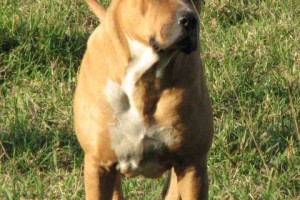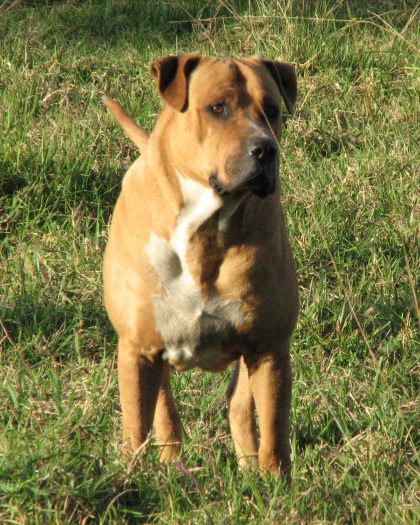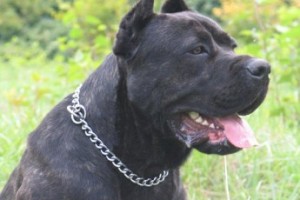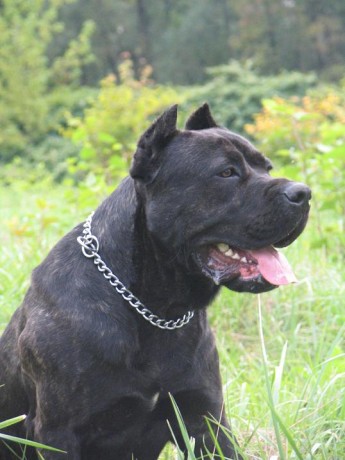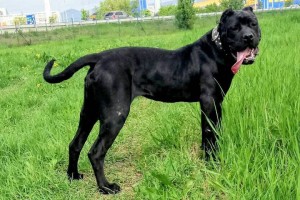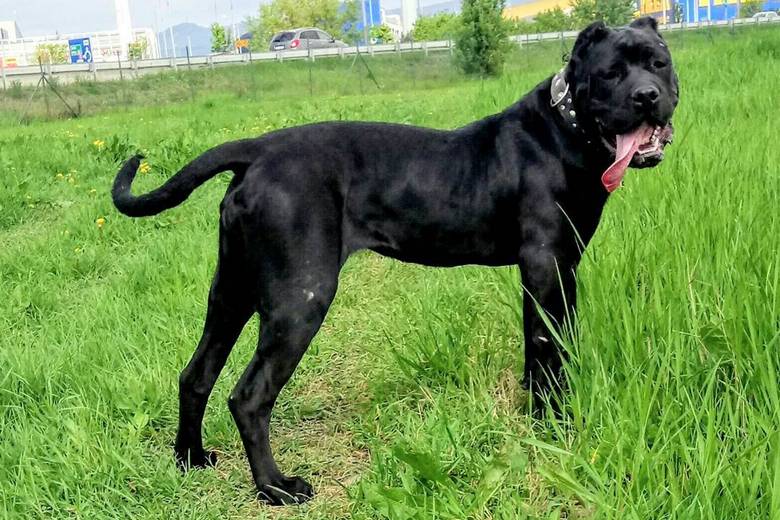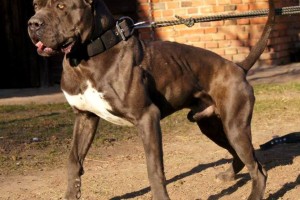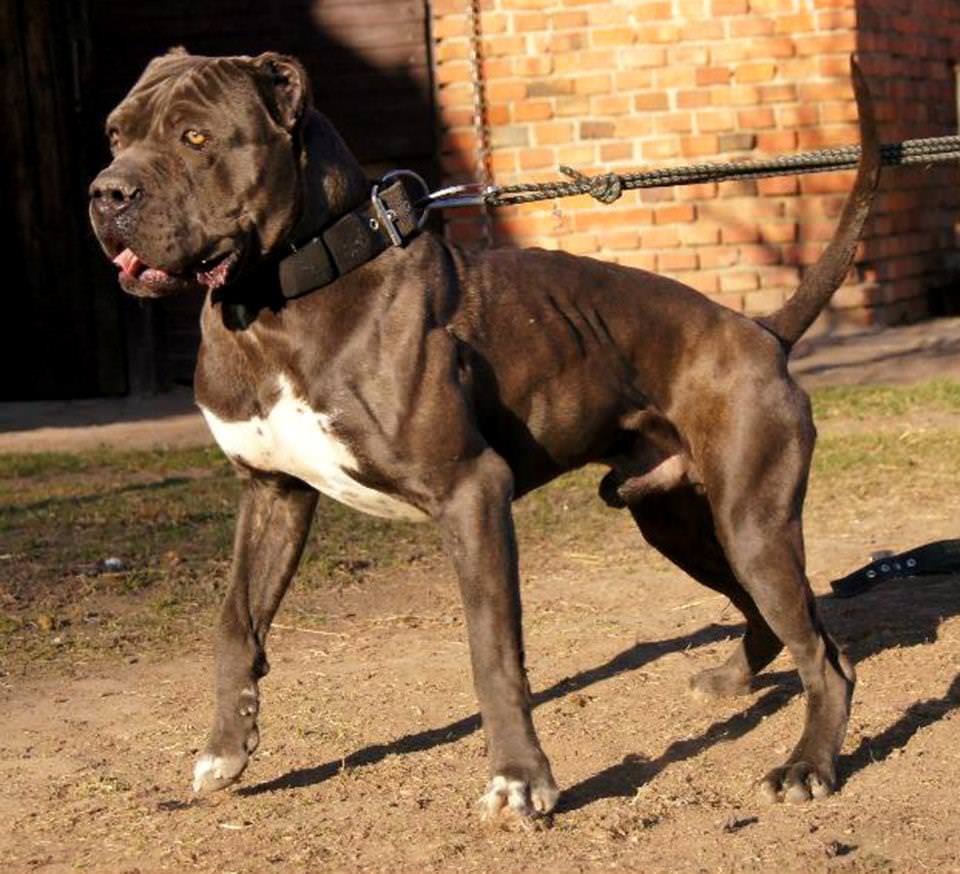Bandogge Standard - Draft
Bandogge Standard Version 5.1 - updated 2 Jun 2006 Bandogge Standard
Introduction It was later in its history that the dog became known as the "Bandogge" because the breed did not exist under some other name. The extraordinary courage possessed by these dogs is hardly believable. Bred from a long line of fighting ancestors, a dog was length arrived at of such ferocity and courage as to seem almost insensible to pain.
The Early History of the Bandogge. It is impossible to say how the Bandogge originated, most writers are of the opinion that all dogs originated from the wolf (ancient dogs), but the development of the Bandogge still remains a mystery. The Bandogge probably was selected from both Bull Baiting and the Guardian Mastiffs or the cross of both from the war dogs used in the Crusades (medieval battles that took place during the 11th through 13th centuries). William Harrison, in his description of England (1586), first mentions the word in his statement, "Bandogge which is a huge dog, stubborn, uglier, eager, burthenouse of bodie, terrible and fearful to behold and often times more fierce and fell than any Archadian or Corsican cur." It is assumed that the word "Bandogge" originated from the use of strong bonds and chains to secure the dogs. Dr. Caius (1576) states that , among others characteristics, the "Mastiff or Bandogge is serviceable against the fox and the badger, to drive wild and tame swine out of meadows, and pastures, to bite and take the bull by the ears, when occasion so required". The bandogs of old were strictly working crossdogs of various sizes and usually coarse-haired hunters, fighters and property protectors without a strictly set type, developed from eastern shepherds and mastiffs crossed with western Bullenbeissers and hounds, with a few local bloodlines eventually being established as specific types in some regions, such as Britain, Spain, Germany, Poland and elsewhere in Europe. One of the most famous bandogge programs in England led to the establishment of a recognized breed, resulting in what is today the Bullmastiff.
Modern Breed Description: A great number of local bandogge strains have emerged worldwide and these working crosses exist under a variety of names, but the breed commonly accepted as the Bandogge today was developed in the 1960's by American veterinarian John Swinford, who set out to create a property guardian dog superior to all others. Another notable developer is Joe Lucero, whose American Bandogge Mastiff is seen by many as the ideal working breed and a perfect representative of what a true bandogge should be. There are other bandogge strains in existence under different names, but the Swinford and Lucero lines are the most famous and rightfully celebrated for their stable temperaments and outstanding working qualities. Most agree that APBT x Mastiffs crosses were used. Dogs were bred from strains that have temperament, phenotype, to do home guardian or personal protection. The Bandog is a rugged dog, heavily boned and muscled, intimidating when seen and is ferocious when provoked. Broad skull, short to long muzzle depending on the strain of Bandogge with hard bites, wide shoulder, powerful chest, great agility, intelligence and very well controlled dog. The Bandogge, any variety, is strictly a working breed and should be a result of serious and dedicated planning, starting from careful selection of parent breeds and more importantly, appropriate representatives of those breeds, with the health and temperament testing being on the top of the list of priorities, while the uniformity in appearance is the last of the breeders' concerns. Appearance: Height and weight will vary on strains which comprise of different component breeds. This is not a giant among dog, but he is a massive animal, very muscular and well balanced overall, showing great strength. He should be alert and with natural guard behavior. His body symmetrical and well proportioned. The dog should have the appearance of an athlete demanding, compact, muscular and proud.
Foundation Breeding:
The first group , approximate average of 12,5-75%: American Pit bull Terrier APBT, American Staffordshire Terrier AST, and Staffordshire Terrier ST. The Second group ,approximate average of 12,5-75%: AKC Mastiff, Bullmastiff and Neopolitan Mastiff . The third Group approximate average of 0- 75%: American Bulldog, Boxer, Boerbell, Bulldog Campeiro, Bullterrier, Cane Corso, Dogo Argentino, Dogue de Bordeaux, Fila Brasileiro, Great Dane, Olde English Bulldog, Presa Canario, Rotweiler and Tosa.
OBS: To apply for registry on Bandogge the cross required F3(Generation).
Size: Males and females: Height: 20-30 Inches Weight: 70-120 pounds
Drives: Natural Guardian ability is required (the methodology of performance test will be described later).
Specials characteristic: Companionable with the family, with intelligence, loyalty and devotion with his master.
Temperament: A fearless adversary to anyone who threatens his master or property. Friendly with other animals and dogs. Display a definite preference for its family, children included, but it is not a dog that gets along very well with a visitor to the home if his master is not at present.
Disposition: Protect his master against any danger, even to give his own life to protect him.
Body: Much more typical of the Compact "Mastiffs" with a structure of a giant APBT, also retains a good deal of the agility passed on to it by the APBT.
Color: Different colors mixed. Most common colors are: yellowish or sandy grey, any brindle color, black, golden fawn, fawn and red. Other colors are allowed too. Red nose and black nose.
Coat: Short, close and medium fine.
Ears: Cropped or natural.
Neck: Very strong, muscular and robust. Eyes: Dark preferable, but may bear some relation to coat color.
Faults: Failure to be worked, failure to work successfully, producer of genetic problems in pups, poor immune system, affected by hip and elbow dysplasia. Excessively undershot to avoid difficult to eat and some diseases related to them. See previous version (4)on Below.
Bandogge Breed Standard - Version 4. Standard adopted from latest version on Molosser Dogs Bandogge Forum. This standard is a work in progress and a final version will be published at a later date.
Introduction It was later in its history that the dog became known as the “Bandogge” due, of course, to the fact that the dog did not exist under some other name like: Killer Hound, War dogs, Molossus, Mastiff, Mastyue, Villaticus, Cathenarius, Bulldogs, Dogue the Force Race and Engelsen Doguen. The extraordinary courage possessed by these dogs is hardly believable. Bred from a long line of fighting ancestors, a dog was length arrived at of such ferocity and courage as to seem almost insensible to pain. In the Mr. Edgar Farman book (1900’s), specialist in Bulldog History, his wrote: ”The first mentioned word “Bulldog” in literature in the year 1500 was with the other oldest spelling of the word that is “bonddogge” and “banndogge” . Mr. Barret Fowler other author of Bulldog books in 1929 wrote: ” In supposing that the Bandog was the ancestor of the Bulldog… Personally, I think not. It is certain that the both dogs were closely allied, but the Bulldog existed as “the Bulldog” at the same period as the Bandog was a recognized breed. Moreover, these dogs differ in several essential characteristics. The Bandog was rough-coated, generally of yellowish or sandy grey colors. He also possessed a keen scent, the Bandog was manufactured breed produced by a cross between the Mastiff and the Fox-Hound which accounts, of course, for the powers of scents possessed by him. The Bulldog cross to produce a Bandog probably has been used because was common to use a Bulldog to improvement others breeds”.
The Early History of the Bandogge. Its is impossible to say how the Bandogge originated, most writers are of opinion that all dogs originated from the wolf (ancient dogs), but the development of the Bandogge still remains a mystery. When we look up the records, it seems probably that the Old Bulldog must have been crossed with the Mastiff and the Bull Baiting selection. The Bandogge probably were selected for both the Bull Baiting and the Guardian Mastiffs or the cross of both from the war dogs used in the Crusaders (medieval battles that took place during the 11th through 13th centuries). William Harrison, in his description of England (1586), mentions the word “Bandogge” because “ many of them are tied up chains and strong bonds in the day time for doing hurt abroad, which is an huge dog, stubborn, uglier , eager, burthenouse of bodie, terrible and fearful to behold and often times more fierce and fell than any Archadian or Corsican cur. Dr. Caius (1576) states that , among others characteristics, the “Mastiff or Bandogge is serviceable against the fox and the badger, to drive wild and tame swine out of meadows, and pastures, to bite and take the bull by the ears, when occasion so required”.
Modern Breed Description: The component breeds used to make the old bandog is not completly known. Most agree that Bull x Molosser crosses were used. Dogs were breed based just from strains that have temperament, phenotype, to do working ability. The Bandog is a rugged dog, heavily boned and muscled, intimidating when seen and is ferocious when provoked. A powerful dog with man and beast stopping capabilities there is no doubt this dogs role played in the old world. Broad skull, short to long muzzle depending on the strain of Bandog with powerful bites, wide shoulder, powerful chest with a rear to match, the Bandog has lived through out the centuries as still present day. Still adhering to the traditional crossed many have created superb strains. The Bandog still serves its traditional role and does well in personal protection work, sport work, estate guardian as well as fighting in countries which have legal forms of dog fighting. This is the Bandog in all its glory.
Appearance: Height and weight will vary on strains which comprise of different component breeds. We have supplied several varying Bandog appearance categories based on know component breeds used in creating a Bandog Line. This is not a giant among dog, but he is a massive animal, very muscular and well balanced overall, showing great strength. He should be alert. His body symmetrical and well proportioned. The dog should have the appearance of an athlete demanding, compact, muscular and proud. Foundation Breeding: “A working cross, bred to perform one or more tasks, predominantly of Mastiff / Bull breed cross”. The first group at least 25% to 50% of: American Pit bull Terrier APBT, American Staffordshire Terrier AST, Staffordshire Bull Terrier SBT, Staffordshire Terrier ST . The Second group at least 25% to 50% of: AKC Mastiff, Boerbell, Bullmastiff, Fila Brasileiro, Neopolitan Mastiff, Rotweiler and Tosa. The third Group must have less than 25% % of : American Bulldog, Dogo Argentino, Dogue de Bordeaux, Great Dane, Olde English Bulldog and Bulldog Campeiro. The fourth Group must have less than 12,5% of: Boxer, Cane Corso and Presa Canario.
OBS: To call Bandog the cross required F3 at least in one side. After F3 shall avoid Pure Breed cross introduce. If needed the preference are to cross a Bandog from other kennel (at least F3) to add “vigor” without lose the Working Ability and avoid F1 segregation.
Size: Size will depend on the dogs genetics and the job it is required to. Males and females: Height: 20-30 Inches Weight: 70-120 pounds Drives: Guardian, Hunting, “Farm Work” and Extreme Sport together also any hard work drive is required.
Specials characteristic: Companionable with the family owner with intelligence and loyalty and devotion with his master and sometimes stubborn.
Temperament: A fearless adversary to anyone who threatens his master or property. Friendly with other animals and dogs. Display a definite preference for its family, children included, but it is not a dog that gets along very well with a visitor to the home if his master is not at home.
Disposition: Protect his master against any danger, even to give his own life to protect him.
: Much more typical of the Compact “Mastiffs/Mastins” with a structure of a giant Pit-bull, also retains a good deal of the agility passed on to it by the Pit-bull.
Color: “A good dog cannot be a bad color”. Different colors mixed. Most common colors are: yellowish or sandy grey, any brindle color, black, golden fawn, fawn and red. Other colors are allowed too. Red nose and black nose.
Coat: Short, close and medium fine.
Ears: Preference to a small to big size and hanging.
Neck: Very strong, muscular and robust. Eyes: Dark preferable, but may bear some relation to coat color.
Faults: Failure to be worked, failure to work successfully, producer of genetic problems in pups, poor immune system, affected by hip and elbow dysplasia. Small head in proportion with the body. Excessively undershot to avoid difficult to eat and some diseases related to them.

